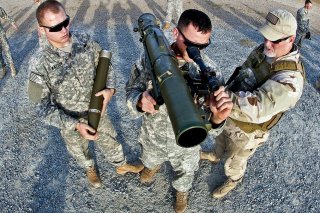A U.S. Army General Explained to Us How AI Could Win the Next War (And More)
TNI presents a special interview with General Murray, Commanding General of Army Futures Command, U.S. Army.
The National Interest (TNI): How is AI progressing and integrating when it comes to Army weapons and technology development?
General Murray: “We have an AI task force led by Carnegie Mellon University in Pittsburgh. We see great potential in artificial intelligence. There are certain places in the country where there is at least some concern about the application of AI to military systems. The whole project Maven thing ran into a little of that. Secretary Esper signed off on guidelines for the application of AI. There was a guy named John Boyd in the Air Force who came up with this concept called the OODA Loop, which means Observe Orient Decide and Act... if you can observe and get inside the OODA Loop of your adversary, that means you can get to understanding and action faster. I actually think that is a great way to look at what I believe is the most logical and valuable use of AI for military applications….that is the ability to see first, decide first and act first, faster than any adversary. The ability to see, understand, decide and act faster than an adversary in what is going to be a very hyperactive battlefield in the future I think would be number one when it comes to the fast application of AI.”
TNI: What is the status of the Army’s Robotic Combat Vehicle program?
General Murray: “We had a soldier touchpoint where we were putting robotic vehicles in the hands of soldiers at Fort Carson. That was supposed to take place in the second week of March. That was postponed and we are going to try to make that up this summer. We’ve been using light robots in Iraq and Afghanistan for the better part of a decade plus our EOD (Explosive Ordnance Disposal) guys working to stop roadside bombs and vehicle-born bombs. We have moved onto medium robotic vehicles. The mediums are probably about 10-tons or so and that is what we were going to do some experimentation with at Fort Carson. We have not yet done experimentation with what we call heavy class... 20 to 30-ton class vehicles.”
TNI: How fast do you see autonomy developing in terms of combat readiness?
General Murray: “You can imagine that the higher up you go in weight, the more you can put on it. We are looking at algorithms that enable them to cross terrain. So, we have spent a lot of time looking at the secure link between the robotic vehicle and the soldier in the vehicle itself. I think robotics will fundamentally change the way we fight in the future.” Experimentation is just as important as the technology, which includes understanding what this will do in terms of what formations will look like in the future and how they will be employed. What is the greatest value from a reconnaissance standpoint? Or a weapons standpoint? What are the linkages to make sure we have secure linkages?”
TNI: What are some of the next moves when it comes to Army Robotics? Which Army units are involved?
General Murray: “The University of Texas made a $50 million investment to build us a robotics laboratory. We were supposed to start that this month, but that has been delayed until June or July. There is a lot of partnership between the University of Texas and my lab—specifically ARL South, the Next Generation Combat Vehicle Cross Functional Team and PEO Ground Combat Systems to push the envelope.”
TNI: How are the drones and unmanned systems being networked in terms of a new concept for Combined Arms?
General Murray: “Up at CMU (Carnegie Mellon University) they are working on algorithms to link ground and air vehicles—and it becomes not manned-unmanned teaming but unmanned-unmanned teaming. Go out in this grid square and go identify this threat, so from a ground and air perspective, those vehicles talk to each other. We are collecting training data to train our algorithms.”
Kris Osborn is the new Defense Editor for the National Interest. Osborn previously served at the Pentagon as a Highly Qualified Expert with the Office of the Assistant Secretary of the Army—Acquisition, Logistics & Technology. Osborn has also worked as an anchor and on-air military specialist at national TV networks. He has appeared as a guest military expert on Fox News, MSNBC, The Military Channel, and The History Channel. He also has a Masters Degree in Comparative Literature from Columbia University.

